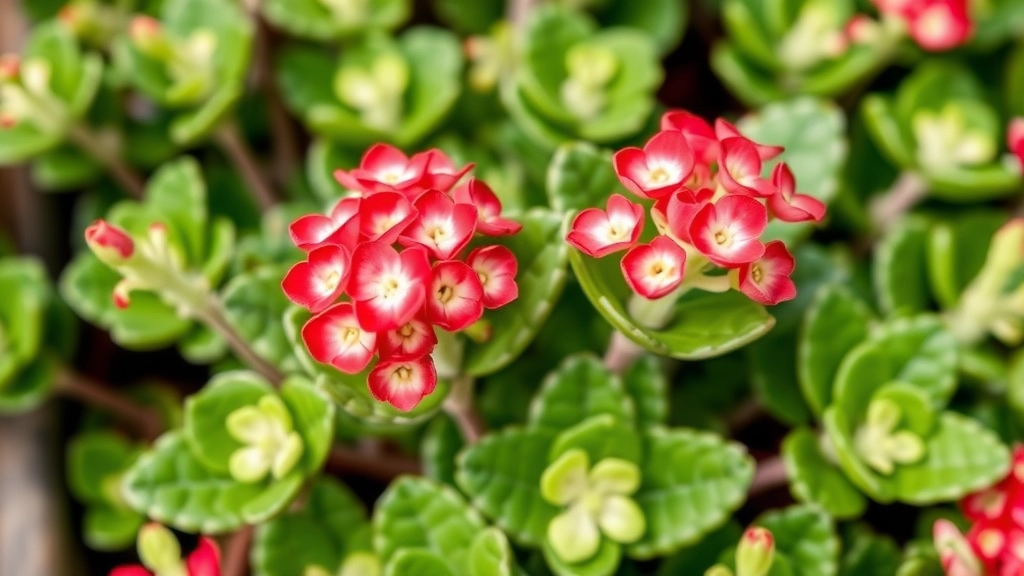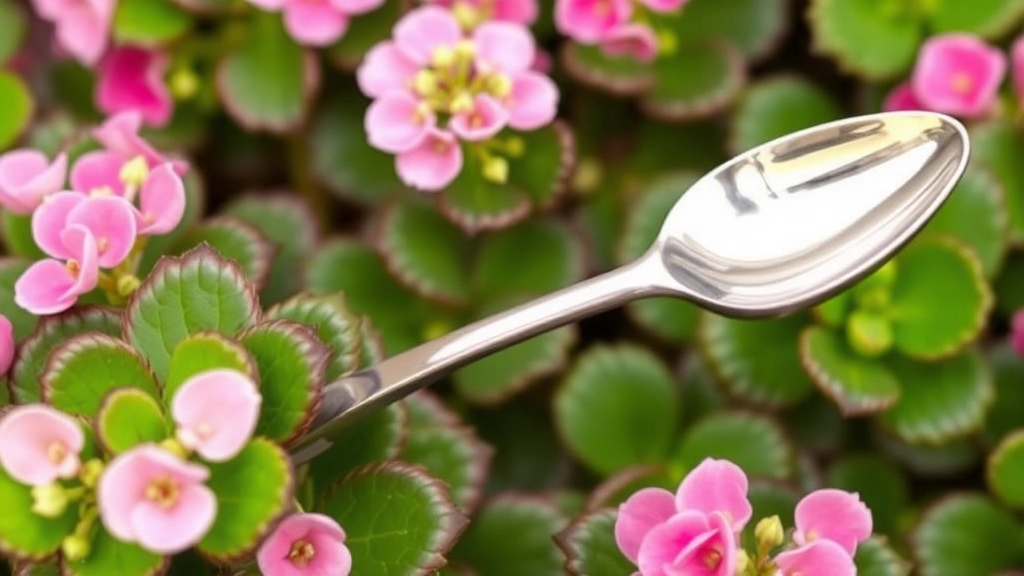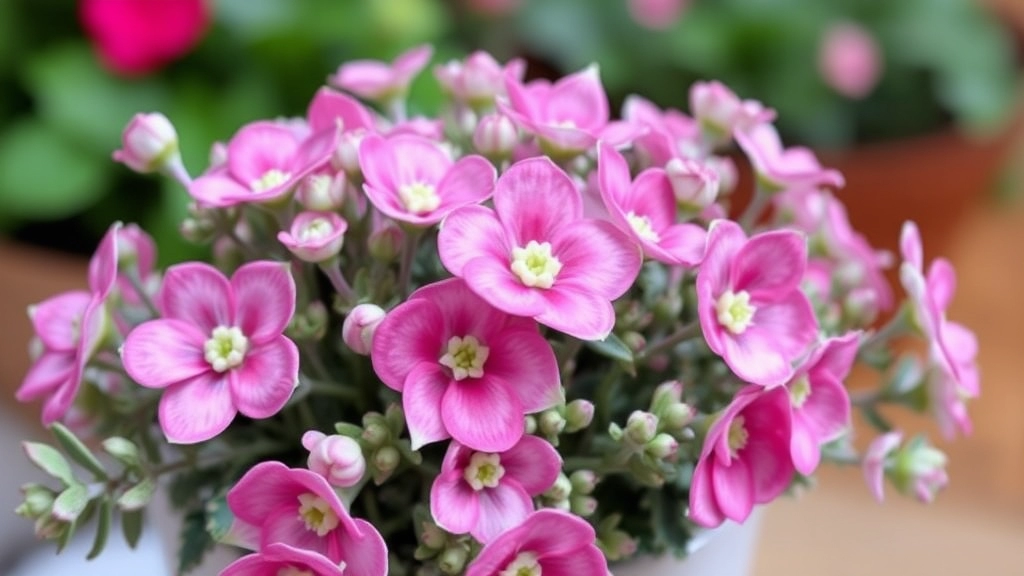Kalanchoe Silver Spoons Care Guide
If you’re looking to add a unique touch to your indoor garden, Kalanchoe Silver Spoons might be the plant for you. This succulent is not only easy to care for but also adds a striking visual element with its silver-hued leaves. In this guide, I’ll walk you through everything you need to know to keep your Kalanchoe Silver Spoons thriving.
From selecting the right potting mix to understanding its watering needs, I’ll cover all the basics to ensure your plant stays healthy and vibrant. Whether you’re a seasoned plant parent or a newbie, these tips will help you master the art of Kalanchoe Silver Spoons care.
Are you intrigued by the unique beauty of Kalanchoe Silver Spoons? This captivating succulent is not just a feast for the eyes; it has a personality that makes it a favourite among plant enthusiasts.
Kalanchoe Silver Spoons, scientifically known as *Kalanchoe luciae*, is celebrated for its striking, spoon-shaped leaves that boast a silvery-grey hue.
Key Features:
– **Leaf Structure**: The leaves are thick and fleshy, resembling spoons, which store moisture and contribute to the plant’s drought resistance.
– **Colouration**: The silvery appearance is enhanced by a subtle blush of pink at the edges, especially when exposed to sunlight.
– **Growth Habit**: This succulent typically grows upright, reaching heights of about 30 cm (12 inches) and forming a rosette shape that adds architectural interest to any space.
– **Flowers**: While primarily grown for its foliage, Kalanchoe Silver Spoons can produce clusters of small, tubular flowers, usually in shades of orange or red.
Understanding these characteristics not only helps you appreciate the plant but also prepares you for its [care](https://planthq.org/complete-guide-to-kalanchoe-plant-care/).
If you’re interested in propagating this stunning succulent, you might find this [step-by-step guide](https://planthq.org/how-to-propagate-kalanchoe-copper-spoons-cuttings-2/) useful.
Ideal Growing Conditions for Kalanchoe Silver Spoons

So, you’ve got your Kalanchoe Silver Spoons and you’re wondering, “What does this plant need to thrive?”
Let’s dive into the ideal growing conditions that will make your plant flourish.
Light
- Bright, Indirect Light: Kalanchoe Silver Spoons loves bright light but can’t handle direct sunlight for too long.
- South or East-facing Windows: These are your best bets for optimal light exposure.
Temperature
- Warm Temperatures: Aim for a cozy range between 20°C to 25°C (68°F to 77°F).
- Avoid Cold Drafts: These plants aren’t fans of chilly air, so keep them away from windows during winter.
Humidity
- Low to Moderate Humidity: Kalanchoe Silver Spoons does just fine in average household humidity.
- No Need for Misting: Unlike some tropical plants, this succulent prefers to stay dry.
Soil
- Well-Draining Soil: A cactus or succulent mix works wonders. You want it to drain quickly to prevent root rot.
- pH Level: A slightly acidic to neutral pH (around 6.0 to 7.0) is ideal.
Potting
- Terracotta Pots: They’re great for succulents since they allow moisture to escape.
- Size Matters: Choose a pot that’s just a bit bigger than the root ball to avoid water retention.
Planting and Potting Tips
When you’re ready to plant your Kalanchoe Silver Spoons, you might be wondering about the best way to get started. Choosing the right pot and soil can make a significant difference in your plant’s growth and health.
Watering Requirements for Kalanchoe Silver Spoons

One of the most common concerns for plant enthusiasts is how often to water their Kalanchoe Silver Spoons. This succulent thrives on a careful balance of moisture, and getting it right is crucial for its health.
Understanding Water Needs
Kalanchoe Silver Spoons prefers dry conditions, making it essential to avoid overwatering. Here are some key points to consider:
- Soil Type: Use well-draining soil, ideally a cactus or succulent mix, to prevent water from pooling around the roots.
- Watering Frequency: During the growing season (spring and summer), water when the top inch of soil feels dry. This usually translates to every 2-3 weeks, depending on your environment.
- Winter Care: In the dormant months (autumn and winter), cut back on watering. Once a month is often sufficient, as the plant requires less moisture during this period.
Signs of Overwatering and Underwatering
Recognising the signs of improper watering is key to maintaining a healthy plant.
- Overwatering: Yellowing leaves, mushy stems, and a foul smell from the soil indicate excess moisture. If you notice these symptoms, allow the soil to dry out completely before watering again.
- Underwatering: If the leaves appear shrivelled or wrinkled, your Kalanchoe may be thirsty. In this case, give it a good soak, ensuring water drains out of the pot.
Best Practices for Watering
- Use Room Temperature Water: Cold water can shock the plant.
- Water Thoroughly: Ensure water seeps from the drainage holes, confirming the roots are adequately hydrated.
- Adjust for Climate: Hotter, drier climates may require more frequent watering, while cooler, humid environments may need less.
When nurturing your Kalanchoe Silver Spoons, fertilization can often be a source of confusion.
**How much and when should I fertilize?**
Here’s the scoop:
– **Type of Fertilizer**: Use a balanced, water-soluble fertiliser. A formula with a ratio of 20-20-20 is ideal.
– **Dilution**: Always dilute the fertiliser to half the recommended strength. This prevents over-fertilisation, which can harm your plant.
– **Frequency**: Fertilize every 4-6 weeks during the growing season (spring and summer). In autumn and winter, cut back to once every 8 weeks or stop altogether.
– **Application**: Apply the fertiliser directly to moist soil to avoid root burn.
**Signs Your Plant Needs Fertiliser**:
– Yellowing leaves
– Stunted growth
– Lack of blooms
**Tips for Success**:
– **Timing**: Fertilize in the morning or late afternoon to avoid leaf burn from the sun.
– **Watering**: Ensure your Kalanchoe is well-watered before fertilising. This helps the plant absorb nutrients effectively.
For more detailed care instructions, you might find the [guide to caring for Kalanchoe house plants](https://planthq.org/guide-to-caring-for-kalanchoe-house-plants-in-the-uk/) particularly useful. Additionally, if you’re interested in propagating your Kalanchoe, check out the [step-by-step guide on propagating Kalanchoe leaves](https://planthq.org/how-to-propagate-kalanchoe-leaves-a-stepbystep-guide/).
Common Pests and Diseases

So, you’ve got your Kalanchoe Silver Spoons thriving, but what happens when those pesky pests come calling?
Pests to Watch Out For:
- Mealybugs: These little white fluff balls love to hide in the leaf joints. They suck the sap and can weaken your plant.
- Aphids: Tiny green or black bugs that also feast on your plant’s sap. They can multiply quickly, so catch them early.
- Spider Mites: If you notice fine webbing on your leaves, it might be spider mites. They thrive in dry conditions and can cause leaf drop.
Diseases to Keep an Eye On:
- Root Rot: Overwatering can lead to this sneaky disease. If your leaves are yellowing and mushy, check those roots!
- Powdery Mildew: A white powdery substance on leaves? That’s powdery mildew, often due to poor air circulation.
Prevention Tips:
- Inspect Regularly: Make it a habit to check for pests. Catching them early makes a world of difference.
- Good Airflow: Ensure your plant isn’t crowded. Good airflow helps prevent diseases.
- Water Wisely: Avoid overwatering to keep root rot at bay.
Pruning and Maintenance of Kalanchoe Silver Spoons
Maintaining your Kalanchoe Silver Spoons is essential for its health and beauty.
Many plant enthusiasts often wonder how to keep their succulent looking vibrant and lush.
Propagation Methods for Kalanchoe Silver Spoons

So, you’re thinking about multiplying your Kalanchoe Silver Spoons? Great choice! Propagation is a fun way to expand your collection or share with friends.
Leaf Cuttings
One of the easiest methods is through leaf cuttings. Here’s how to do it:
- Select a Healthy Leaf: Look for a plump, healthy leaf.
- Cut It Off: Using a clean, sharp knife, cut the leaf at the base.
- Let It Callus: Place the leaf on a dry surface for a few days. This helps prevent rot.
- Plant It: Once it’s callused, place it in well-draining soil.
- Water Sparingly: Give it a light misting until you see new growth.
Offsets
Kalanchoe Silver Spoons often produces offsets, which are little baby plants that grow around the base. Here’s how to separate them:
- Identify Offsets: Look for small plants that have roots.
- Gently Remove: Use your fingers or a small tool to carefully pull them away from the main plant.
- Replant: Place them in their own pots with the same well-draining soil.
Seed Propagation
If you’re feeling adventurous, you can also propagate from seeds, though it’s a bit trickier:
- Gather Seeds: Collect seeds from mature flowers.
- Sow Them: Sprinkle seeds on the surface of moist soil.
- Cover Lightly: Lightly cover them with a thin layer of soil.
- Keep Moist: Mist regularly until they germinate.
Propagation can be a rewarding experience.
Seasonal Care and Considerations for Kalanchoe Silver Spoons
As we transition from one season to another, the care requirements for your Kalanchoe Silver Spoons will change. Understanding these seasonal needs is essential for keeping your plant healthy and vibrant.
Spring: Awakening Growth
In spring, your Kalanchoe Silver Spoons will start to show signs of new growth.
- Light: Ensure it receives bright, indirect sunlight.
- Watering: Increase watering frequency as the plant comes out of dormancy.
- Fertilization: Start feeding with a balanced fertiliser every four to six weeks.
Summer: Thriving Conditions
Summer is the peak growing season for your plant.
- Temperature: Keep it in a warm environment, ideally between 20-25°C.
- Watering: Water when the top inch of soil feels dry.
- Humidity: Maintain moderate humidity; avoid overly humid conditions.
Autumn: Preparing for Dormancy
As the days grow shorter, your Kalanchoe will prepare for dormancy.
- Light: Gradually reduce direct sunlight exposure.
- Watering: Decrease watering frequency; the plant will need less moisture.
- Fertilization: Stop fertilising as growth slows down.
Winter: Dormant Phase
In winter, your Kalanchoe Silver Spoons enters a dormant phase.
Frequently Asked Questions about Kalanchoe Silver Spoons
What are the ideal light conditions for Kalanchoe Silver Spoons?
Kalanchoe Silver Spoons thrives in bright, indirect light. South or east-facing windows are ideal for optimal light exposure.
What temperature range is best for Kalanchoe Silver Spoons?
These plants prefer warm temperatures between 20°C to 25°C (68°F to 77°F). It’s important to avoid cold drafts, especially during winter.
Does Kalanchoe Silver Spoons require high humidity?
No, Kalanchoe Silver Spoons does well in low to moderate humidity and does not require misting.
What type of soil is best for Kalanchoe Silver Spoons?
Use well-draining soil, such as a cactus or succulent mix. The ideal pH level is slightly acidic to neutral, around 6.0 to 7.0.
What kind of pot should I use for Kalanchoe Silver Spoons?
Terracotta pots are recommended as they allow moisture to escape. Choose a pot that’s just a bit bigger than the root ball to avoid water retention.
How often should I water Kalanchoe Silver Spoons?
During the growing season (spring and summer), water when the top inch of soil feels dry, usually every 2-3 weeks. In the dormant months (autumn and winter), water once a month.
What are the signs of overwatering or underwatering?
Overwatering can cause yellowing leaves, mushy stems, and a foul smell from the soil. Underwatering can lead to shriveled or wrinkled leaves. Adjust your watering accordingly.
How can I prevent pests and diseases on my Kalanchoe Silver Spoons?
Regularly inspect your plant for pests like mealybugs, aphids, and spider mites. Ensure good airflow and avoid overwatering to prevent diseases like root rot and powdery mildew.
What are the methods for propagating Kalanchoe Silver Spoons?
You can propagate Kalanchoe Silver Spoons through leaf cuttings, offsets, or seeds. Each method involves specific steps to ensure successful propagation.
Leaf Cuttings
Select a healthy leaf, cut it off, let it callus, plant it in well-draining soil, and water sparingly until new growth appears.
Offsets
Identify offsets with roots, gently remove them, and replant them in their own pots with well-draining soil.
Seed Propagation
Collect seeds from mature flowers, sow them on the surface of moist soil, cover lightly, and mist regularly until they germinate.
Can Kalanchoe Silver Spoons be kept outdoors?
Yes, but only if the outdoor conditions meet the plant’s needs for light, temperature, and humidity. Avoid exposure to direct sunlight for prolonged periods and protect the plant from cold drafts.
References
-
The Spruce – Kalanchoe Silver Spoons Care
-
Gardening Know How – Kalanchoe Silver Spoons Care
-
House Plants Expert – Kalanchoe Silver Spoons
